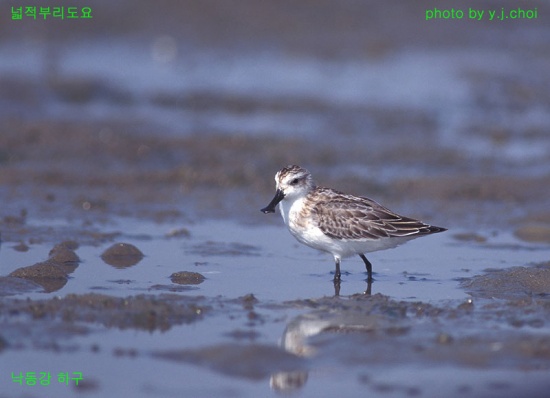m (Typo) |
(User template) |
||
| Line 1: | Line 1: | ||
| − | |||
;[[:Category:Eurynorhynchus|Eurynorhynchus]] pygmeus | ;[[:Category:Eurynorhynchus|Eurynorhynchus]] pygmeus | ||
| + | [[Image:Spoonbill_Sandpiper.jpg|thumb|550px|right|Photo by {{user|ilovebird|ilovebird}}<br />[[South Korea]]]] | ||
==Identification== | ==Identification== | ||
The average size of the adult Spoon-billed Sandpiper is six inches (about fifteen centimeters).<br /> | The average size of the adult Spoon-billed Sandpiper is six inches (about fifteen centimeters).<br /> | ||
Revision as of 16:02, 26 April 2010
- Eurynorhynchus pygmeus
Identification
The average size of the adult Spoon-billed Sandpiper is six inches (about fifteen centimeters).
The Spoon-billed Sandpiper Is a small peep-relative with a unique spatulate-shaped bill. The breeding adult has a rufous head, neck, and chest, with a white underbody and white-outlined black feathers on the upperbody
The Juvenile lacks the reddish coloration of the adult, but has white coloration instead with a dark "cheek" and crown.
Similar Species
The plumage of this sandpiper is almost exactly like the Red-necked Stints, but can be separated from this peep by the different bill-shapes and darker auriculars and a more sharply defined supercilium on the juvenile Spoon-billed. But the strange bill shape can be hard to see from a distance and some sandpipers with mud stuck on the bill tip can look as though they have the spoon shape.
Distribution
The Spoon-billed Sandpiper is a rare bird and highly endangered. The global population is low, estimated about 1,000 breeding pairs. They breed in Northeast Russia. In migration and winter they are rare, and are found on the east coast of Asia as far south as the Philippines. 84 were recently found at two sites in Myanmar. There have been a few records of the Spoon-billed Sandpiper in North America; around five in western Alaska and one breeding adult in British Columbia.
Taxonomy
This is a monotypic species[1].
Habitat
The breeding habitat of this bird is on sea coasts with sand and low lying vegetation in the arctic tundra of Northeast Russia. They also spend time in brackish water. The Spoon-billed Sandpiper winters are intertidal flats and estuaries of the eastern coast of Asia. Habitat loss of the wintering wetlands are the main reason for this species low population. Luckily, some of this peep's habitat is being conserved and saved.
Behaviour
Breeding
Display: Each pair of Spoon-billed Sandpiper hold relatively small territories. The males territorial display has trilling calls, sharp dives, circling in loops, and hovering above the ground.
Nesting: The Spoon-billed Sandpiper nest is built on the ground on the arctic tundra, and usually holds four eggs. They are incubated by both the mother and father, though the mother leaves when the precocial chicks hatch. The father then takes over caring for the young until they are 17 days old, then leaves them to fend for themselves.
Diet
As post peeps, the SBSA forages in shallow water, and mudflats during the winter. The specialized spatulate bill helps the bird grab clams, arthropods, and other invertabrates living in the sand and mud that the bill stirs up as it sweeps from side to side. During the winter the Spoon-billed Sandpiper feeds farther out from shore than the similar Red-necked Stint, which is one way to distinguish the two.
Vocalisation
The call is often described as a high "wheet". They also make staccato, trilling calls in territorial display flights.
References
- Clements, JF. 2009. The Clements Checklist of Birds of the World. 6th ed., with updates to December 2009. Ithaca: Cornell Univ. Press. ISBN 978-0801445019.
Recommended Citation
- BirdForum Opus contributors. (2024) Spoon-billed Sandpiper. In: BirdForum, the forum for wild birds and birding. Retrieved 15 May 2024 from https://www.birdforum.net/opus/Spoon-billed_Sandpiper




